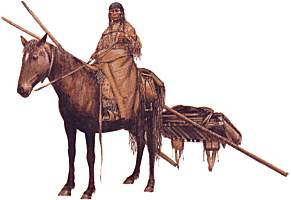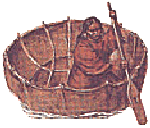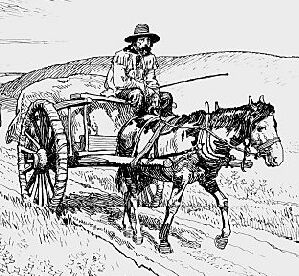
The travois was an A-shaped frame
with a platform for carrying things.
Early Spanish explorers brought horses to North America. Some of the horses ran away and wandered northward to the plains in the early 1700s. The horses were caught and tamed by the Plains Peoples. A horse could pull a larger travois than a dog. Larger loads could be carried and people no longer had to walk.

The birchbark canoe was a light boat.
It was easy to portage (carry) between rivers and lakes.
The Plains Peoples crossed the rivers with canoes, rafts and bull boats.
The birchbark canoe originated with the Algonquin tribes. It was used for hunting, fishing and collecting wild rice. The outer covering of the canoe was made from large sheets of white birch. The birch bark had to be carefully peeled from the tree. The frame, ribs and flooring were from the white cedar. The roots of trees were used to sew the pieces of bark together.
A bull boat was a small boat built of willow branches covered with bison hides. The hide was first soaked in water, then stretched around the "hoop" frame made of branches. The boat was usually made with the hair facing inside. It was used for hauling wood and to ferry loads across rivers.

A short paddle carved from wood
was used to steer the bull boat.
In the winter it was difficult to get around in the deep snow. Toboggans or sleds pulled by dogs was one way to travel. People used snowshoes to walk in the snow. Snowshoes were invented by the Aboriginal Peoples. The snowshoes were made of wooden frames. Sinews were used for the netting. Strips of leather kept the snowshoes tied to a person's feet.
The Cree who lived in the forests of northern Saskatchewan survived by hunting, trapping and fishing. They used dog teams and toboggans in the winter to follow their traplines and to carry furs and loads.

Red River carts were made entirely of wood.
During the time of the fur trade and before the railroad was build, Red River carts were used to carry heavy loads. Oxen or horses pulled the carts. The carts floated and could be used as rafts when a river had to be crossed.

| index | introduction | words | beliefs | food | clothing | tipi | bison |
| decoration | family & daily life | tools | transportation | links |

** information for teachers **
credits for graphics and information
J.Giannetta, 2002
(updated July 2011)
Web Pages for Students